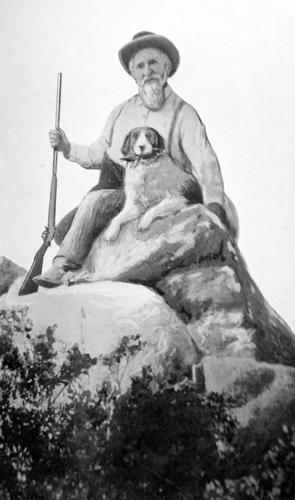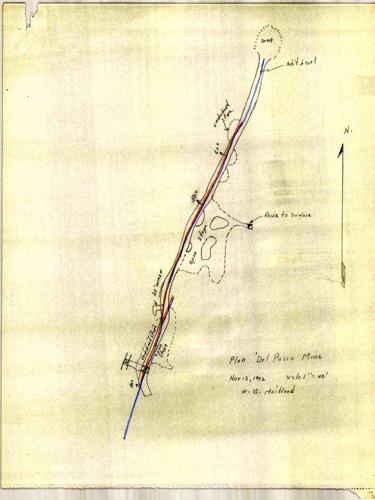The Bradshaw Mountains in Central Arizona near Prescott produced a series of big strikes in the 1870s and ’80s. The earliest to be developed in the range was the Del Pasco Mine.
It was discovered by Jackson McCrackin, James Fine, Charley Taylor and T.G. Hogle on July 4, 1870. Within a month, two arrastras were employed to extract gold with an initial processing of 112 ounces totaling $1,904. The former placer mine was further developed to access the Del Pasco vein (running 2 to 3 feet in width) which, later heavily worked, necessitated the establishment of a tunnel 1,000 feet in length and stoped to the surface.
Located in the Pine Grove District of Yavapai County on the rugged southern slopes of Tower Mountain overlooking Crown King, the Del Pasco vein, between 6,300 feet and 7,300 feet, strikes north-northeast. The local geology is diorite intruded by rhyolite porphyry and a primary quartz vein with galena, pyrite and sphalerite.
Early ore sampling led to a proclamation in the local Prescott newspaper, The Miner, that a rich mineral wealth could be found in the Bradshaw Mountains. Early mining ventures around the Del Pasco Mine included placer mining, with many miners seeking a small fortune, between $5 and $20 a day, using implements such as rockers and pans to extract gold.
Jesse and Cal Jackson acquired an interest in the Del Pasco from Hogle for $1,000. They improved the operation with a four-stamp mill operated onsite during the early 1870s. The mill also processed ore from the nearby War Eagle Mine. Lack of water proved a hindrance to milling operations and the mill seldom ran at full capacity, averaging 40 to 50 ounces of gold every couple of days.
Jackson McCrackin was a member of the Walker Party and also a member of the First Territorial Legislature. He received his initiation from pauper to wealth in the Bradshaw Mountains and later mining ventures in Mojave County, including the discovery of the silver-rich McCracken Mine. McCrackin, a man who previously was lacking in personal hygiene, was forcibly bathed and groomed by his political and mining colleagues to better fit the role of a proper Territorial Arizona representative according to the image of the mining industry.
By the 1880s, the Del Pasco Mine was overshadowed by other nearby mines in the area, including the Tiger and Peck mines.
However, production continued on a minimal scale, including that undertaken in 1886 by Lester Jackson and John Curtin, who leased the nearby Basin Mill to process ore. Additional ore from the mine was also sent to the Tuscumbia Mill along Tuscumbia Creek south of Battle Flat through 1888. “Diamond” Jo Reynolds, a prominent mine investor, had holdings at both the Congress Mine and Del Pasco Mine.
Later operations included 50 tons of ore produced by Blauvelt and Watts in July of 1892. Reoff and Carner worked the area in 1922, operating an arrastre while working a tunnel on the north slope at 6,700 feet. The vein uncovered was part of the Jackson Strata, yielding $40 of gold per ton.
Early recorded production yielded $200,000 in gold and silver.
Small mining operations proceeded sporadically throughout the 20th century with discovery of some high-grade ore. Development over the decades included an 85-foot-deep shaft along with two tunnels with drifts. Equipment included a portable compressor and gas hoist.
During the early 1940s, Lawrence DeZee, then the mine owner, was shipping 35 tons or two cars of high-grade ore per month. The average profit was $500 per car including gold, silver, lead and copper, with the bottom of the stope producing more zinc and lead. A three-man operation involved 400 feet of drifting on the Jackson Strata vein measuring up to 4 feet thick with hand steel and stoping.
The lack of a mill on the property necessitated that the ore be processed at a custom mill rehabilitated by the Metals Reserve Co. at Crown King and in some cases shipped to the El Paso smelter for processing of the high lead content. Between 1941 and 1946, the mine produced 378 tons or ore comprised of gold, silver and lead.
Sampling of the mine dumps at the Del Pasco Mine was initiated in the late 1980s to determine the mineral value potential of heap leaching. However, nothing of consequence has occurred at the mine site since.
Today it is a remote stop accessed several miles from the Senator Highway for tourists and off-road enthusiasts.





